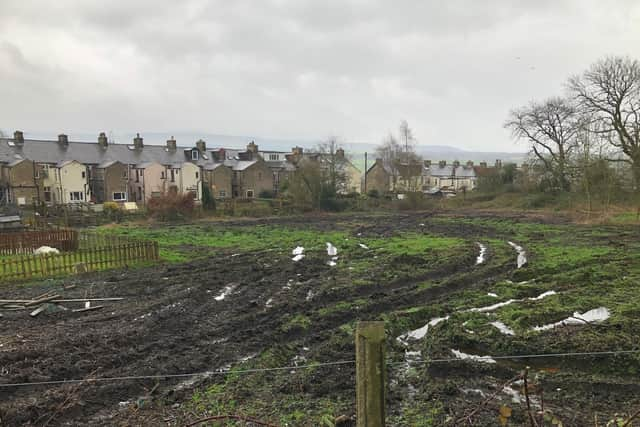Burnley Council leader slams 'faceless, unelected bureaucrats of Whitehall' for allowing developer's appeal to build homes on 'natural beauty spot'
and live on Freeview channel 276
And news that the appeal against Burnley Council, which turned down the application for the Vicarage Avenue site twice, has been upheld, was slammed by angry council leader Coun. Mark Townsend.
He said: "I am disgusted that the government's planning inspector has ridden rough shod over local democracy by allowing the appeal of the developer to build on this land at Vicarage Avenue, Padiham.
Advertisement
Hide AdAdvertisement
Hide Ad"The residents were against it, the town council against it, the borough council was against it. The land wasn‘t even listed in the local plan for development.


"We have the ridiculous situation where the Secretary of State for Housing, Communities and Local Government has just refused to intervene in a planning application approving a new coal mine in Cumbria saying it should be 'a decision for local democracy.'
"If that’s the situation for Cumbria let's have the same in Padiham.
"The whiff of double standards fills the air. Residents have badly let down by faceless unelected bureaucrats based in Whitehall."
Advertisement
Hide AdAdvertisement
Hide AdAlthough the inspector's decision can be challenged in the High Court it would have to be on the basis on the law in making the final decision had not been properly followed.
Although it had been recommended for conditional approval, members of the Development Control committee voted 12 to 3 to turn down the application to build six detached bungalows on the area of land known as Craggs Farm in July. The decision came four months after the first application was made.
Members of Burnley's Development Control committee refused the plan to build the bungalows on the grounds that it was considered to be 'detrimental to the character and appearance of the area.'
In a report presented to the committee by planning officers the development was described as not being in keeping with the surrounding area by virtue of its 'poor design and layout.'
Advertisement
Hide AdAdvertisement
Hide AdThe plan was also kicked out on the grounds that because it would be built so close to several homes in Whalley Road there would not be enough distance to ensure privacy to the homes.
But residents' celebrations were shortlived as the plan was re-submitted in April with alterations made to the distance from the existing homes in Whalley Road.
But the new and amended plan was described as a 'cosmetic makeover' of the original plan by Padiham Community Action.
The campaign against developing the site in Vicarage Avenue began after it was cleared last year leaving residents angry as the area has long been acknowledged as a 'natural beauty spot' with an abundance of wildlife and vegetation including bats, owls, wild flowers, lilac, trees and deer in the summer months.
Advertisement
Hide AdAdvertisement
Hide AdThe area is part of the Huntroyde Estate and lies in a triangle between Blackburn Road, Vicarage Avenue and Whalley Road. There is a building known as Craggs farmhouse on the western boundary.
The site was not included in Burnley's Local Plan, which was adopted last year and sets out the overall strategy for development up to 2032.
Padiham Town Council objected to the application by Reedley Properties Ltd and Lancashire County Council had expressed concerns about parking and access issues.
In recent months the site has started to return to its natural state and deer has even been spotted there for the first time in months.
Advertisement
Hide AdAdvertisement
Hide AdIn his report the government inspector draws up a list of reasons for granting the appeal and these include his view that the proposed dwellings are sited at such a distance from the existing homes they would not cause a 'sharp or harmful' contrast in their appearance. He also said they would not be 'dominant ' features in the area or 'dilute the presence' or compromise the privacy of the existing Victorian terraced homes.
In his report the inspector said: "On my site visit, I observed that in the wider area there are several examples of different property styles and layouts, with properties built over various eras.
"Such a situation represents a typical evolution in the design, layout and appearance of residential areas in many towns and cities.
"The view that the development has no benefit to the community or environment is not determinative.
Advertisement
Hide AdAdvertisement
Hide Ad"In my experience the provision of bungalow developments can often meet a local demand that is not typically catered for in larger housing developments, and through landscaping and biodiversity enhancements, the scheme can provide some environmental benefit."
The inspector also said he had not been presented with any evidence to suggest that the new development would be at risk of or cause a flood risk or would have an unacceptable impact on highway safety.
Concerns had also been expressed about grade two listed building Craggs farmhouse which is on the site and dates from 1840. There are also associated barns and stables which are also grade two listed, surrounded by mature trees and a landscape setting.
The inspector concluded that no harm would be caused to the settings of the listed buildings by the development because they already have an established suburban, rather than rural location, and because the proposal incorporates sufficient physical separation and distinctiveness of design.